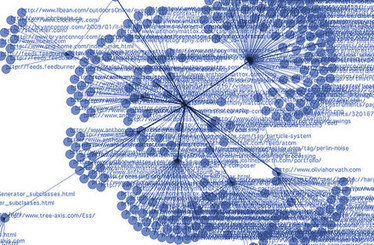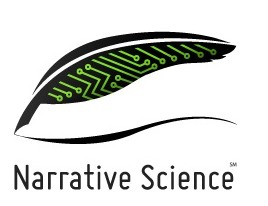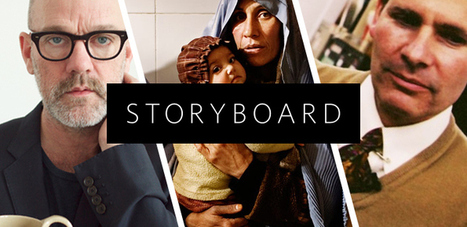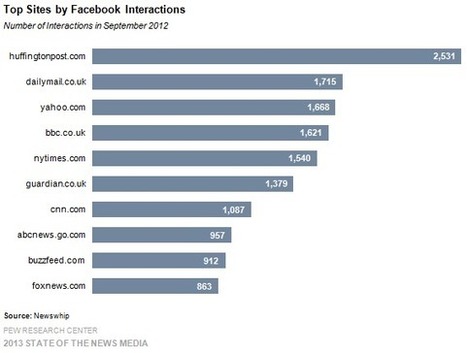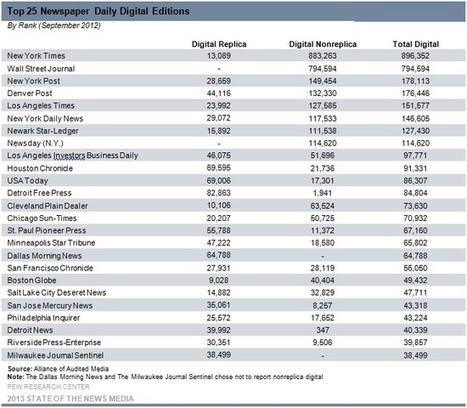 Your new post is loading...
 Your new post is loading...
The media industry may be hurting, but journalism -- and access to information -- is flourishing. Journalists may just have to work smarter, and network more, to keep up.... Journalism is not in crisis. The media industry — and journalists — might be, but the journalism itself is actually improving. Such is the argument made by international documentary filmmaker Bregtje van der Haak and Annenberg professors Michael Parks and Manuel Castells in a recently published article about “Networked Journalism.” As the authors see it, the problem is that most of the doomsayers mix the concept of journalism with the business of journalism. In their article, journalism is defined as the “production of reliable information and analysis needed for the adequate performance of a democratic society.” Not mentioned in the definition are “profits,” “professional journalists” or “traditional publishers.” Just the pursuit of reliable information....
Every 30 seconds or so, an algorithm developed by Narrative Science produces a computer-written news story, Wired reports. The articles run on the websites of respected publishers like Forbes, as well as other Internet media powers (many of which are keeping their identities private). Niche news services hire Narrative Science to write updates for their subscribers, be they sports fans, small-cap investors, or fast-food franchise owners. And the articles don’t read like robots wrote them....
Alternative weekly colossus Boston Phoenix cracked and fell this week, ceasing publication after 47 years. Once one of the leading alt-weeklies in the nation, the dead paper leaves behind $1.2 million in debt and roughly $500,000 in assets. ...The advertising shift from newsprint to Web is mirrored by a cultural shift. In my mind, the alt-weekly remains the perfect boredom-alleviation device. Waiting for a subway train? Pull one from your bag and it will entertain you. Your girlfriend is late for your date? The paper will keep you occupied. That beer and bag of nuts not distracting from life’s troubles as you mope on a barstool? The alt-weekly saves the day again. But even a human fossil must concede that the smartphone trumps the alt-weekly as a boredom killer. How does a wedge of newsprint compete with an affordable messaging device that ferries games, social media apps, calendars, news, feature films, scores, coupons and a library’s worth of music and reading material? Ask a young person his opinion and he’ll tell you that nothing says “geezer” like a newspaper, be it daily or alt-weekly. What’s changed, and what probably convinced the Phoenix to exit, is that the papers are no longer a 30 percent (or higher) margin business, and that lost business is not returning. Publishers who hope to survive will have to content themselves with 10 percent margins. They will have to work harder to maintain advertising categories where they still have a comparative advertising advantage, such as food and restaurants, which usually require a face-to-face meeting between an ad representative and an owner to make a sale. It’s a cliché, but I’ll toss it out there anyway: Every newspaper and website needs to compete in the events business. The smarter papers are already there, and if they’re lucky they’ll hit the jackpot the Austin Chronicle has with its decades-old SXSW business. And it doesn’t require much insight to urge alt-weekly publishers to continue building out their Web components....
The grizzled vet and the digital native: Journalism has plenty of room for both to succeed. I spent eight years at AOL and I'll say this: I saw none of the great, all of the bad and some of the good. ... The blood sport during my AOL days was about the future of media companies — who would or wouldn’t survive the digital onslaught. Actually, it was much the same during my time at Newsweek in the 80s (who needed three newsweeklies in a broadcast world). Ditto when I joined The New York Times in the 70s (was the city big enough for both The Post and Daily News). Now, the social Web with its echo chamber turns up the volume daily — and makes it more personal, too. It’s far more about the fate of the individual journalist. That quickly gets down to the paycheck. Will there be one? How much? Who gets it — the “professional” or the pretender? Consumer demand for credible news and information is greater than ever. The problem is the 100-year-old model for producing it is forever broken. That’s why more attention must be paid to finding new ways to produce quality journalism — efficiently, at scale and at a price supported by mobile CPMs, which at best are 50% lower than desktop CPMs, which if you’re lucky come in two-thirds lower than print CPMs. In other words, a high-cost newsroom structure built for the print age will never work in a smartphone or tablet world. A few startups are experimenting with new models — Vox Media, Machinima, Bleacher Report and Storify are a few that I follow. Among traditional media companies, FORBES is the only one I know of charting a new course....
I will never forget Bob Feit, the mad Hungarian who ran the newsroom I landed in right after college. When the news really excited him, he would pound his fist on the rim (a horseshoe-shaped copy desk), then jump on his desk and wave his arms with utter joy. “I love the news,” he would yell. The slot man, a Brit who wolfed down onion sandwiches for lunch, would express mild amusement as he continued to move copy to Carmine, a.k.a. Ace, the gruff-on-the-outside, sweet-on-the-inside teletype operator. I also remember Feit (no one ever called him Bob) because he taught me to write concisely. He would sit to my right, cut my two-sentence news briefs in half, then tell me to fill them up with facts. When I finished, he would do it again. To this day, I write my posts with Feit in mind, knowing he’d easily find words to cut....
|
...At their core, Facebook, Tumblr, and Twitter are sharing networks, not publishing companies. They act as platforms for other people’s content, which can be spread rapidly and massively among their communities. A consequence of being walled gardens that restricts this sharing activity within their own properties, however, is that they give up the right to decide when and how that content breaks free into the wider public discourse. Even though it had success with its partnerships program at placing stories into other forums, Storyboard’s stories always had the whiff of marketing, or what is these days being described as “native advertising.” As we now know, that ultimately did not work out for Tumblr. Going by Fletcher’s comments, perhaps Facebook Stories will meet a similar fate....
When Facebook introduced its redesigned News Feed, it did more than change how people view memes and photos of cats — it altered the way stories are seen. Now everyone can make news. But for those who make a living by spreading news, Facebook has changed the way stories are presented. Dean Praetorius, a senior editor with The Huffington Post, talked with AllFacebook about how the way news is presented on Facebook requires some changes to the traditional approach. The Huffington Post has recently been lauded for its popularity on Facebook. Pew Research Center presented findings regarding news and social media, citing a study by Newswhip showing that the online newspaper was by far the most engaged news source on Facebook. In terms of Facebook interactions, HuffPost beat out more traditional companies, such as The Daily Mail, The New York Times, and CNN. How did HuffPost accomplish this? Praetorius said that the company has taken a well-rounded approach to social media, knowing that the story is far from completed when it’s published. HuffPost also thinks about stories differently from print media outlets and TV stations. Praetorius said that stories on the site are meant to generate conversation, and not so much to simply inform, as an old-school newspaper would...
If the newspaper industry had theme music in 2013, it might use “Been down so long it looks like up to me,” the much-recycled line from a 1920s blues song. For the first time since the deep recession that began in 2007, newspaper organizations have grounds for a modicum of optimism... Companies have started to experiment in a big way with a variety of new revenue streams and major organizational changes. Some of the bright opportunities – such as offering social marketing services to local businesses – are ventures too new to be measured yet industry-wide. They show signs of stabilizing revenue.... Even halting improvement in the general economy helps the industry. The double whammy of cyclical ad losses on top of secular shift to new media has considerably eased from the worst of the recession from 2007 to 2010. Auto advertising has come back, and some markets, like Miami, are beginning to see recovery in real estate and employment ads as well. All those positives, however, are for the time being mostly promise rather than performance. The most basic indicators have not turned around. The industry is little more than half the size it once was. Considerable dangers persist... So the industry entered 2013 with some positive signs but still dealing with difficult economic realities. The two biggest newspaper developments of the last year – digital paywalls and reduced print frequency – capture that odd mix of expansion and contraction now typical within the industry....
Bill Keller obviously has something of a love/hate relationship with the internet. The former New York Times executive editor has written columns questioning the societal value of Twitter and web news aggregators like the Huffington Post. On the other hand, he’s rather active on Twitter, where he has more than 50,000 followers, and it was under his tenure that the Times became an enthusiastic user of that platform, among a slew of other digital technologies. And now he’s officially a new media guru, having been a speaker at SXSW Interactive in Austin this week. Keller, who’s been writing for the Times’s Op-Ed page since handing over the top job to Jill Abramson in 2011, was a guest on a panel about digital bullying. After that discussion, I caught up with him for coffee and a chat. When I asked if it was okay to record our conversation, he quipped, “That depends what you’re going to ask me.”...
Polis, the journalism think-tank at the LSE, has published an in-depth report looking at the value of social media to journalism, specifically public service broadcasting, and it highlights how Twitter has come to dominate news. As the report puts it, Twitter plays a more important role in newsgathering than Facebook, which is much more about discussion and far less about breaking news. Lyse Doucet, the BBC’s Chief International Correspondent puts it this way: “There is no question, if you are not on Facebook and Twitter, you are not getting the full story”. More telling is the comment from Joanna Carr, editor of BBC Radio 4′s news programme ‘PM’, who said she “wouldn’t hire anybody who doesn’t know how to use Twitter”....
|
 Your new post is loading...
Your new post is loading...
 Your new post is loading...
Your new post is loading...




